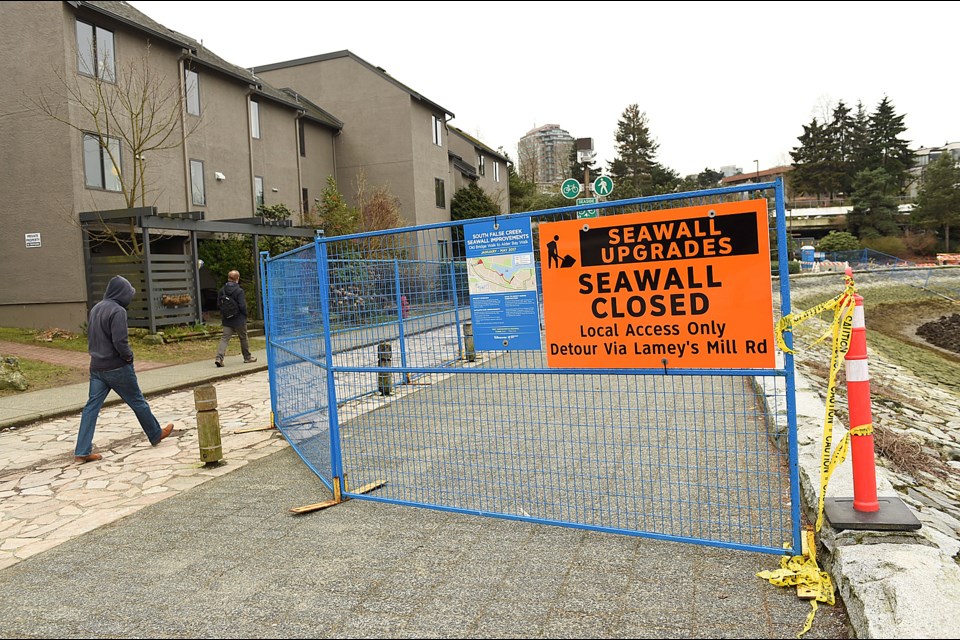A long detour on the South False Creek seawall might be frustrating to pedestrians and cyclists but the City of Vancouver is asking for people’s patience a little bit longer.
When the city embarked on improving the oldest section of the seawall, it didn’t expect to discover there were water pipes underneath the path, says director of transportation Lon LaClaire. Since these pipes were also showing signs of aging — this section of the seawall was created 30 years ago — it made sense to replace them at the same time the separated bike and pedestrian paths were being created.
“At first we thought it would be a minor project with targetted intervention,” LaClaire told the Courier. But when the community consultation process began, the project grew in scope as the public weighed in on the changes they’d like to see, including the creation of separated pedestrian/cycling lanes. Then the water project was added, requiring major disruption.
“We have to bring big equipment into a small space,” LaClaire said. The deep trenches required for the pipe work made safe passage impossible.
He knows the long detour is cumbersome but says the engineering department is working hard to finish the project by the time warmer weather returns. If the work isn’t finished on time, the seawall will be re-opened and finished later.
The stretch of seawall between the Granville and Cambie bridges was created in 1975 through a former industrial area; Granville Island was just being developed. Fast forward to today and in the summer there are upwards of 5,000 cyclists a day “and probably more walking,” La Claire says. Without separated lanes, this was leading to accidents and conflicts between the pedestrians and cyclists sharing a narrow space.
“Older people especially felt uncomfortable,” he says. As well, the former flagstone surface was considered a trip hazard, hence the decision to create a flat, paved surface.
To create the separated paths, a row of cherry trees had to be cut down. LaClaire said the trees were planted 30 years ago; not only is the lifespan of a cherry tree around 20 years, but the ground around the trees was tightly packed.
Those trees will be replaced by a row of cherry trees that will act as a separation between the bike and pedestrian paths, further reducing potential conflict. “In a year or two they’ll be far more substantial than the trees that had been there for 30 years. You’ll see a bigger tree canopy and they’ll have a healthy life ahead of them.”
As to concerns that there will still be conflicts between cyclists out for a Sunday ride and commuter cyclists, LaClaire says the city is making changes to enhance the seaside bypass route through this area.
Charleson Road, which runs parallel to West 6th Avenue, from School Green Road and Moberly Road, is now closed to vehicular traffic. Only the number 50 bus, pedestrians and cyclists will be allowed. Signage on the seawall will be improved to let commuting cyclists know how to get to an alternate and safe east-west route.
While this stretch of road is sometimes used by people trying to avoid traffic on West 6th, primarily people who live in the area will be affected, LaClaire says. The city met with staff at the Parent Advisory Council at False Creek Elementary School, who he said agreed to the street closure. It will complicate access to the school but also make the area safer for children because there will no longer be through traffic, he says.
However, the chair of the PAC disagrees with LaClaire's assessment of public support. "It seems that the only contact we had with the city was at a public consultation meeting where one of our executive members expressed concern regarding the use of the school ground as a thoroughfare for commuting cyclists," Larissa Warrington said in an email to the Courier. "We certainly did NOT agree to the closure of Charleson road to vehicle traffic as this closure negatively impacts our families by removing a major access point to our school."
Barriers have been installed to prevent cars from travelling on the road. The barriers will allow for a single lane for buses going in both directions. This should not be a safety hazard because there is enough time between buses.
LaClaire says some cities discourage traffic by creating tracks for buses, which are wider than a normal car track. Vancouver hopes that the barriers will be enough of a deterrent.
“There’s nothing that will stop people from driving through the barriers except a sign that says they can’t,” he says. However, given that the stretch of road runs alongside Charleson Park for 500 metres, drivers who break the law will be breaking it for quite a distance, making them more prone to being caught.



